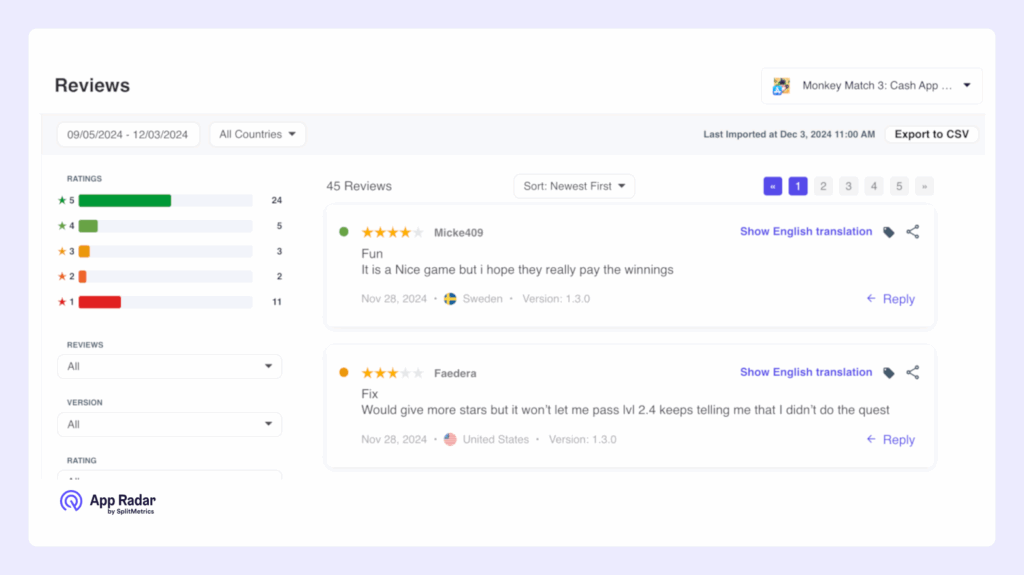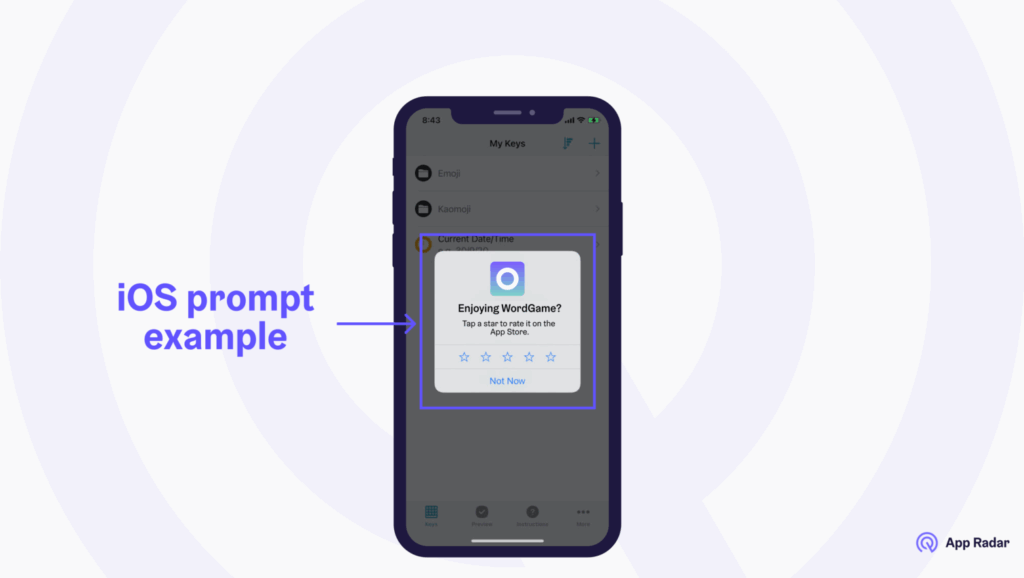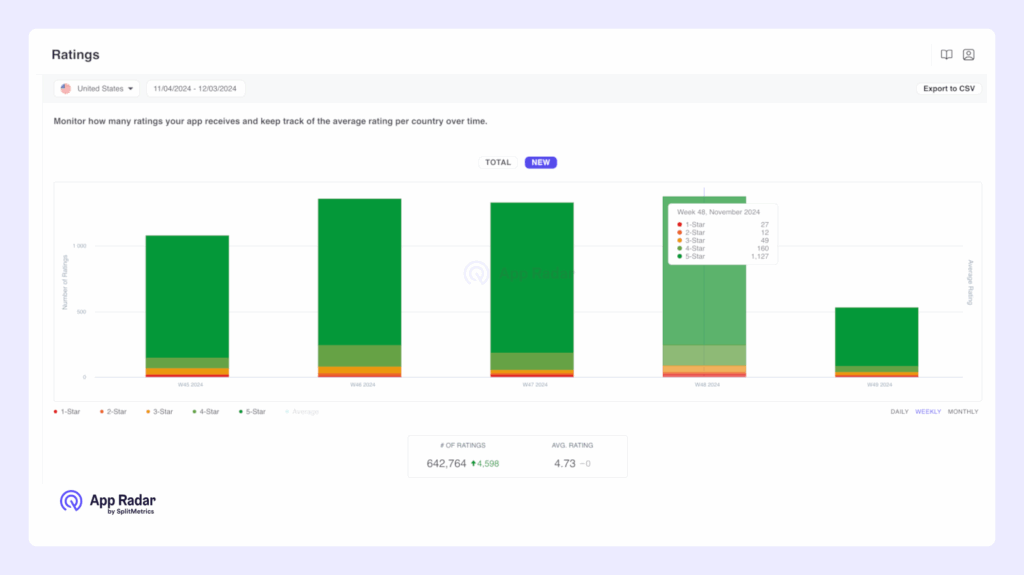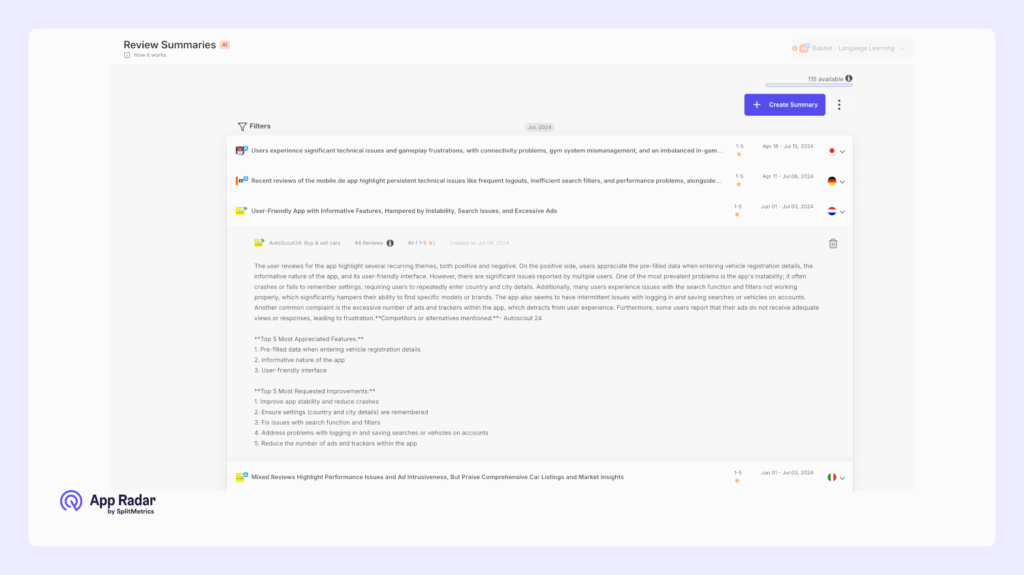Beginner’s Guide to App Store Ratings & Reviews
 Gabriel Kuriata
Gabriel Kuriata Ratings and reviews on the App Store represent the public feedback that iOS users provide for the apps they use. The ratings and reviews significantly impact app store optimization and conversion rates, and are displayed in various locations on the App Store.
Apps with many positive ratings immediately show users what other people think of them. App reviews provide more detailed information by offering a textual description of what is good or not about the app.
Highly rated apps have a higher probability of being featured in either automatically or manually curated lists and editorials on the App Store and Google Play.
Managing App Store ratings and reviews is one of the most crucial activities for every app marketer. In this introductory guide, we will provide sufficient information to help you enhance the feedback your iOS app receives.
App ratings on the App Store measure how well users like a particular app. Users can rate an app from 1 to 5 stars, with 5 being the highest rating. The app’s overall rating is the average of all user ratings.
App ratings can significantly impact an app’s visibility and success on the App Store. Higher ratings can attract more downloads and improve an app’s ranking in search results. Conversely, low ratings can harm an app’s reputation and decrease visibility.
IOS app ratings are visible in multiple places throughout the App Store: in search results, product pages, featured categories, and ad placements. Due to their significant presence, similar to app ratings and reviews on Google Play, they have a substantial impact on the entire user experience and journey.

Apple calculates an app’s rating on the App Store by averaging all user ratings for that app. As users rate an app on a scale of one to five stars, the overall rating is calculated by adding up all the ratings and dividing the total by the number of ratings received.
For example, if an app has received 10 ratings – four 5-star ratings, three 4-star ratings, two 3-star ratings, and one 2-star rating – the app’s overall rating would be calculated as follows: (4 × 5 + 3 × 4 + 2 × 3 + 1 × 2) / 10 = 3.8 stars. This rating is then displayed on the app’s product page and on the App Store for users to see, as well as wherever the app icon and title are displayed.
Unlike the Google Play Store, Apple assigns the same weight to each rating, regardless of the app version or the age of the rating.
To leave a rating for an app on the App Store, users must first visit the app’s product page. From there, they can tap on the Ratings & Reviews section and select the number of stars they want to give the app, with 5 stars being the highest rating.
Users can also write a review of the app and the rating (more on reviews in the following sections). Users can leave a rating at any time after downloading the app. They can also leave a rating from their “Purchased list” by tapping the app and going to the Ratings & Reviews section.
Developers can encourage users to leave ratings from inside the app or game by displaying a prompt using the SKStoreReviewController API to send the rating directly to the App Store.
Developers cannot delete user ratings or reviews on their own. However, they can choose to reset the average star rating when submitting a new version of their app. This is often done after a major update fixes bugs that caused a flurry of low ratings.
The summary rating is calculated and displayed per country/territory (e.g., the US App Store, the UK App Store). A developer can choose to reset the rating for one territory while keeping it for others.
Resetting the rating only clears the star average. All individual written reviews (the text) remain visible on the product page, even if their corresponding rating no longer contributes to the new average. Resetting the rating is optional in App Store Connect. By default, the ratings from the previous version are carried over.
App Store ratings and reviews are generally anonymous. When users leave a review, their username is displayed alongside the review, but their personal information is not revealed.
App reviews on the App Store are user-generated feedback on a particular app. Every time people rate an app, they can leave a written review of their experience.
The reviews are publicly displayed on the app’s product page on the App Store and can be viewed by anyone. Users can also sort the reviews by most recent or most helpful to get a better idea of the app’s overall performance.

Reviews are textual feedback; they can be positive, negative, or even neutral. Apps with many positive reviews may receive an additional boost on the App Store, often indirectly. If product page visitors install an app due to the positive reviews, this will also impact app keyword rankings, as, according to our observations, download velocity is a significant factor.
Unlike on Google Play, we’ve found no evidence that keywords in app reviews are indexed on the App Store. Nevertheless, the reviews are displayed in prominent positions on the product page and significantly impact app installs because they show potential users what current users think.
App owners can and should monitor app reviews on the App Store, as they play a significant role in reputation management and app store optimization.
App marketers should actively engage with users by responding to reviews, including both positive and neutral ones. This approach may positively impact retention and conversion rates.
How to respond? App owners can thank their customers for their feedback, which encourages existing users to continue using the app and may even prompt them to recommend it to others. Some people will publicly ask questions and raise concerns, which provides a great opportunity to jump in and ensure that the user continues to use the app.
For negative reviews, app owners can address any issues or concerns the user may have and demonstrate their commitment to improving the app.
A portion of app users will share their frustration and dissatisfaction publicly, whether because they are unhappy with the user experience elements, intrusive ads, or if the app has technical issues.
Always reply to negative reviews. Our experience shows that people are likely to change their app rating if they are happy with the answer they received.
App Store ratings and reviews have a significant impact on app store optimization (ASO). Positive ratings improve the tap-through rate in the search results and the conversion rate from the app’s product page.
We have mentioned that app ratings and reviews are important factors that influence an app’s search performance. In our experience, apps with high ratings and positive reviews have a higher chance of achieving better keyword rankings in search results, which in turn improves overall visibility, product page visits, and installs.
Ratings and reviews also impact conversion rates throughout the entire user journey on the App Store, whether through search or browsing different categories.
Finally, ratings and reviews impact the conversion rate of your app’s product page. They can also help you optimize it. If you notice that people describe your app using similar keywords, that is a great chance to update your app’s metadata (app name, subtitle, and keyword field) with these keywords and test how it performs with future updates.
With positive ratings and reviews, the app’s visibility in App Store search results will be higher, and consequently, the chances of receiving more downloads will increase.
App Store Connect is the default tool for managing and analyzing ratings and reviews on the App Store, though external services significantly extend its capabilities.
App Store Connect can be your starting point for mobile app reputation management. There are five primary filters you can find in App Store Connect to explore ratings and reviews:
While useful, for efficient replying and accurate analysis, you might want to consider using an external service like App Radar.
App Radar is an ASO and app marketing platform that offers advanced AI-driven management and analysis features for ratings and reviews. It will enable you to understand user sentiment more effectively and respond to a large number of reviews with ease.

You can monitor your app ratings in time and per country, and have more control over the app reviews. This includes setting multiple filters for review status, country, app version, ratings, and tags. However, even more importantly, you can use premade templates to reply to reviews directly within App Radar.
The AI-powered App Review Summaries option makes the platform shine, allowing users to scan reviews of any iOS app and understand in a couple of minutes what app users think about it. Analyzing your app competitors and understanding what users find essential helps with future app improvements, app store optimization, positioning, and offering features that your competitors don’t.
This method of analyzing app reviews may be crucial when their numbers increase significantly. Every review summary highlights what app users need or miss, providing valuable insights into market research.
While there are many tips and best practices for managing and improving app ratings and reviews in app stores, we suggest focusing first on understanding the process and your options. Here are the four key milestones to follow to optimize your ratings and reviews actively.
First, analyze how you are currently performing compared to your competitors in the same category. Analyzing ratings & reviews is an essential part of ASO competitive research.
You can manually check how many ratings you have, what kind of reviews you receive, and how often.
A smarter and more efficient way is to use App Radar’s AI-powered App Review Summaries. That way, you can quickly understand what real users think about your app, your competitors, what they want to improve, etc.
Ratings play a considerable part in ASO, as mentioned many times already. The best way to get them is to ask for them proactively.
To have the best chance of getting them, you must consider where, when, and how you will ask users to rate your iOS app or game.
You can use a passive approach and add a button to your app that users can tap to leave a rating when they are ready. However, a more proactive approach is likely to yield a higher number of ratings and reviews.

Developers are required to use a native API called SKStoreReviewController, which follows these principles:
Users can altogether disable all in-app review prompts for all apps through their device settings.
Consequently, the best practice is to trigger the prompt at “natural breaks” or after a user has a demonstrably positive experience, such as completing a level in a game or finishing a task. While this approach may seem restrictive, this policy was a response to some apps being overly persistent in their prompts. Managing ratings and reviews requires patience and long-term planning. Asking for reviews should be no exception.
Once you receive new ratings and reviews, you should actively monitor your progress. Specifically, you need to pay attention to the following:
If you want to monitor the entire performance of your iOS app in the App Store, we strongly recommend integrating your App Store account with App Radar. That way, you can manage ratings and reviews and simultaneously check your app’s metrics, such as keyword rankings, clicks, and impressions, competitors, metadata, Apple Ads, and other metrics in one place.

Another key aspect of growing your app’s feedback is actively responding to user reviews. The reality is that grumpy and dissatisfied users are often most motivated to leave a review. In principle, try to respond to all reviews, prioritizing those with negative feedback.
A bad rating and review can damage your app’s reputation. For every one-star review you get, you need seven five-star reviews to average a 4.5-star rating. That is why you need to work ahead to prevent negative reviews.
New and potential app users will see the replies you leave. So, if a potential user sees that you take app complaints seriously, they will be more likely to install the app.
Active replying to reviews helps convert negative reviews into positive ones. At the same time, you ensure that power users (those who spend a lot of time on your app vs. average users) are happy and retained.
You can use App Radar to reply to reviews directly from the tool and load pre-existing or your own custom templates. This not only saves time but is also convenient and easier than browsing through App Store Connect data.

Here are a few principles of how to respond to app reviews:
Apple’s Terms and Conditions have certain restrictions concerning App Store app reviews. It prohibits the use of foul language, disclosing personal data, and spamming within a response. It is also strictly prohibited to offer customers incentives to modify or delete their Apple App Store reviews and rating scores.
If an iPad or iPhone user finds your reply somehow inappropriate, they may report a concern. There is a chance that you may be deleted from the Apple Developer Program in such cases.
However, the guidelines also apply to users reviewing your app, allowing you to report a concern to the App Store. Consequently, you may remove reviews from your app’s product page that are offensive and damaging. The decision of what to delete ultimately rests with the App Store.
Prioritizing user satisfaction and transparent communication not only boosts ratings but also contributes to a lasting and positive relationship between developers and mobile app users.
In this case, answering is a caring act. Let users know you respect and value them by addressing their concerns and expressing gratitude for the feedback, regardless of its severity. By doing so, you’ll be able to earn their trust and identify areas for improvement.
Ultimately, collecting and understanding feedback are among the most reliable paths to success for your app. Don’t ignore it.
Looking to increase the number of reviews for your app? Want to understand user sentiment better? Leverage App Radar’s features to interact with your audience and learn more about their needs through our AI-driven features.

